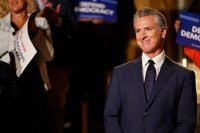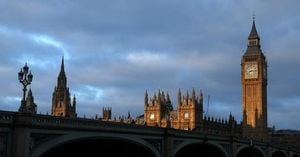California Governor Gavin Newsom has once again thrust himself into the national spotlight, waging a high-stakes political battle that could reshape not only his own future but also the contours of congressional power across the United States. In a series of bold moves and public appearances throughout August 2025, Newsom has positioned himself as the Democratic Party's most aggressive counterweight to former President Donald Trump and the Republican Party, particularly over the contentious issue of redistricting.
On August 21, Newsom held a fiery press conference where he did not mince words, lambasting both Trump and Texas Republicans for their mid-decade redistricting efforts, which many Democrats see as a blatant attempt to lock in GOP advantages ahead of the 2026 midterms. "We will match fire with fire," Newsom declared, vowing to erase any Republican gains in Texas by redrawing California's own congressional map to favor Democrats. According to The Independent, his remarks were not just aimed at his political rivals, but also at fellow Democrats, signaling a new baseline of aggression and determination that he believes the party needs to adopt if it hopes to regain power.
Newsom's redistricting push is more than just rhetoric. He has proposed a plan that, if approved by California voters in a special election slated for November 2025, would sideline the state’s independent redistricting commission and replace its current map through the 2030 elections. The stakes are enormous: Newsom claims his plan could put up to nine congressional seats into Democratic hands, a move that would dramatically alter the balance of power in Washington. As TNND reports, this strategy is intended to directly counter Republican maneuvers in Texas and other states, where GOP-led redistricting is expected to yield significant gains for their party.
This aggressive gambit has not gone unnoticed. A POLITICO-Citrin Center-Possibility Lab survey released on August 20 found Newsom overtaking former Vice President and California Senator Kamala Harris in a hypothetical 2028 Democratic presidential primary matchup among the state’s registered Democratic voters and Democratic-leaning independents. The poll showed Newsom leading Harris 25% to 19%, with a striking 75% of registered Democratic voters expressing excitement about the idea of Newsom running for president, compared to 67% for Harris. Harris, who has largely stepped back from politics since her 2024 defeat and has declined to run for Newsom's soon-to-be-vacant governor seat, now finds herself overshadowed by her home state's current leader.
Newsom’s strategy has also had ripple effects beyond California. John Shaw, director of the Paul Simon Public Policy Institute at Southern Illinois University, told The Independent that Newsom’s bold stance has pressured other ambitious Democratic governors, such as Illinois' J.B. Pritzker, to consider similar redistricting measures—even if such moves are not realistically feasible in their own states. "If Newsom is saying, 'I'm going to go in and change California's districts,' you know, I think others who are on the White House track, including Governor Pritzker, felt maybe a reflexive need to say, 'Well, yeah, we'll consider that in Illinois as well,'" Shaw explained. However, he noted that the practicalities in states like Illinois or Maryland are far more constrained, with limited opportunities to shift congressional seats away from Republicans.
In a further demonstration of his rising national profile, Newsom has been actively courting influential Democrats in early primary states. In June, he appeared alongside South Carolina Congressman Jim Clyburn, a kingmaker in Democratic politics, who introduced Newsom to voters as one of "these candidates that are running for president," according to Politico. This move was widely interpreted as Newsom testing the waters for a 2028 presidential campaign, and it comes at a time when the Democratic field remains wide open, with no clear frontrunner and a party still reeling from recent electoral setbacks.
Newsom’s press office has also embraced a combative public persona, frequently trolling Trump and Republicans on social media by mocking the former president’s writing style and favorite catchphrases. This digital strategy has both energized his base and drawn ire from Trump supporters, further cementing Newsom’s role as a leading figure in the Democratic resistance.
Yet, Newsom’s approach is not without risks. The proposed redistricting plan must still win approval from California voters in November. Should it fail, Newsom could find himself having expended considerable political capital on a divisive issue with nothing to show for it. "That's the real wild card. He does depend on the voters to affirm these maps he wants to use to counter Trump's Texas and other state pushes," said David McLennan, a political science professor and director of the Meredith poll, as reported by TNND. "He will have to find some other issue, even after the Californians vote in November. This might be just the first step for Newsom to take in his 2028 bid."
Adding to the drama, Newsom’s August 21 press conference was unexpectedly disrupted by a large-scale immigration enforcement raid, with dozens of ICE agents arriving at the event site. The incident underscored the fraught political climate and highlighted Newsom’s ongoing opposition to the Trump administration’s immigration crackdown—a stance that has seen California join lawsuits challenging the legality of Trump’s sweeping tariff agenda as well.
Support for Newsom’s efforts is not limited to political operatives. On August 21, 314 Action, a group that backs candidates with STEM backgrounds, announced a $1 million investment to support Newsom’s redistricting initiative, specifically targeting vulnerable GOP House members in five California districts. This financial backing signals that key Democratic-aligned groups see Newsom’s battle as a front line in the party’s fight to regain congressional power.
Despite his growing momentum, Newsom faces significant challenges. During his tenure, California has struggled with a persistent homelessness crisis and soaring costs of living—issues that critics argue could undermine his national appeal. As McLennan put it, "I don't think you can label Newsom a frontrunner. The California baggage is going to be there, but there's nobody else who's a frontrunner right now, and so that works to his advantage."
Looking ahead, two scenarios seem most likely. Either Texas Republicans—facing mounting national pressure—back down, allowing Newsom to claim a rare, unilateral Democratic victory, or they press ahead, forcing Newsom to rely on his ability to rally California voters. In either case, Newsom has managed to set the terms of the Democratic primary debate, defining himself as a fighter willing to take bold risks at a time when many party leaders are seen as overly cautious or out of touch.
As the 2026 midterms approach and the 2028 presidential race begins to take shape, all eyes will be on California. Newsom’s gambit may yet prove decisive in the ongoing struggle for control of Congress—and for the future direction of the Democratic Party itself.




